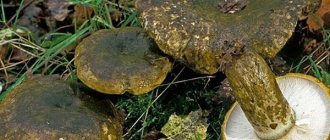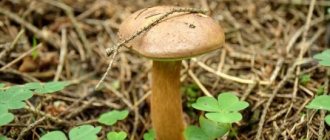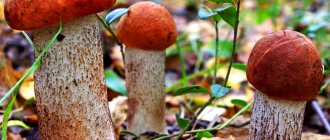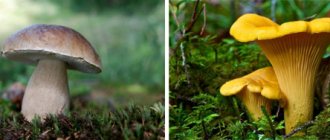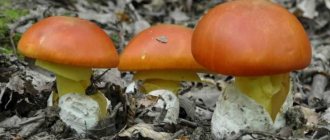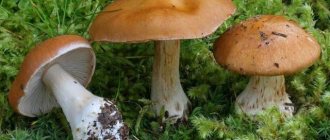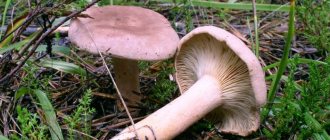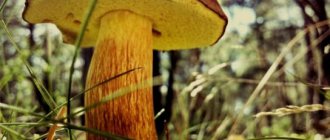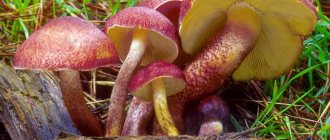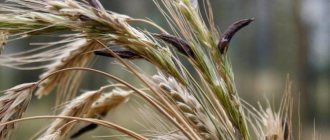Moss mushroom (Xerocomus)
A strong-looking adult mushroom, the boletus mushroom is often confused with the boletus mushroom, a relative of the Boletaceae family, a young one with the boletus mushroom, or even false boletus mushrooms are collected instead, but the edible mushroom has a significant difference, and lovers of “quiet hunting” need to know about it.
The moss fly acquired its name for its predominant habitat in mosses - in forests of temperate latitudes of both hemispheres, on ravine slopes, in the tundra, in the alpine zone, even on stumps and trunks of trees fallen from the wind. It is found under both coniferous and deciduous trees, forming mycorrhiza with spruce, pine, oak, linden, beech, and European chestnut.
Among mushroom pickers, the flywheel is considered a safe mushroom: being a tubular mushroom, which has practically no relatives dangerous to human health, excludes the possibility of mistaking it for some kind of poisonous lamellar mushroom.
Description of edible mushroom
The green flywheel belongs to the genus of the Boletaceae family, the Latin name is Xerócomus subtomentosus. Sometimes it is assigned to the genus Boletus or Boletus, and in Latin it then sounds Boletus subtomentosus. In addition, there are synonyms: Leccinum subtomentosum, Rostkovites subtomentosus and Versipellis subtomentosus.
The cap can reach 16 cm in diameter, but, as a rule, it is found from 3 to 10 cm. It has the appearance of a “pillow”, convex, velvety to the touch. The color is brown with an olive or gray tint.
The hymenophore (lower part) is tubular, adherent, yellow, sometimes with an olive tint. When pressed, it acquires a bluish tint. In adult mature mushrooms, the pores are large, their angular structure is visible.
The pulp is white, most often does not change color when cut, but can become blue or turn blue.
The leg has the shape of a cylinder, often tapering downward. It reaches a height of 10 cm and a diameter of up to 2 cm. The surface is smooth, fibrous, covered with a dark brown mesh. The spores are brown, fusiform.
Lucien Quelet (founder of the French mycological society), discovered several types of mushrooms, one of which was the green flywheel. In total, the scientist described about 200 subspecies.
Useful properties and contraindications
Mushrooms contain many healthy substances: enzymes that promote food digestion; natural sugars, thanks to which dishes made from them are considered low-calorie and suitable for dietary nutrition; vitamins PP, D and B; microelements, including molybdenum and calcium, in terms of the content of which flywheels occupy a leading position among mushrooms.
Fly mushrooms do not produce any harmful effects on the body. Most mushrooms are perceived by the stomach as heavy food, so people with chronic diseases of the liver and gastrointestinal tract are advised to refrain from eating mushroom dishes in large quantities. However, fly mushrooms do not create such a pronounced heaviness effect on the stomach as other mushrooms. Still, you should not offer them to children under 3 years of age and, of course, to those who are allergic to mushrooms.
Growing at home and in the country
Mosswort prefers shade and requires a deciduous tree to grow. Best suited:
- pine;
- beech;
- oak;
- spruce;
- at least fruity.
Around the selected green tree, 30 cm of soil should be removed, approximately 1 m wide. Fill the entire space with a specially prepared substrate, consisting of an equal amount of the following components:
- forest land;
- branches;
- leaves;
- humus.
You will need to add enough soil to create a mound.
To prepare the mycelium, you will need several old flywheels collected from the forest, which should be soaked for a day in a bucket of clean water. After 24 hours, the mushrooms are kneaded into porridge by hand and poured onto the prepared bed. The result is an imitation of forest reproduction.
With the right approach, mycelium will begin to form. The main thing is to water thoroughly, especially in the first couple of months. In a year, the result of your efforts will be visible. You can stimulate the growth of the flywheel with abundant and frequent watering.
How do heated water baths work?
Oddly enough, but a heated outdoor bath provides the necessary relaxation effect for the muscles and nervous system only in conditions of cold or cool air and open space. The higher the contrast, the stronger the effect. Even in frosty conditions, taking into account the heating of the air and warm water mist accumulating above the font, a person feels extremely comfortable.
How to use an outdoor heated swimming pool in cold weather:
- The container, especially plastic or cast iron, is thoroughly washed from dust, the stove is melted, and the font is filled with water. As a result of heating the surrounding space, the steps and platform are heated to a comfortable temperature for the feet;
- After an hour and a half, depending on the intensity of water heating, a warm fog appears above the font. You can take seats in the font;
- The stove damper is closed, and at low speed the firebox provides constant heating and temperature.
The effect created by an outdoor font with a stove is almost impossible to achieve in a bathhouse. Firstly, the warm atmosphere of the steam room cannot be compared with fresh street air, and secondly, when the stove operates at minimum heating, a certain amount of carbon monoxide is formed. In outdoor conditions it does not pose a threat, but inside a bathhouse it can be dangerous.
Mobile hot tub with propane stove
Ice outdoor plunge pool
The situation is worse with wooden hot tubs; in this case, you have to drain the water through a submersible hose, as in the case of an ordinary garden tank. It’s better not to even try to cut the fitting into the bottom or wooden wall; over time, the wood will swell or shrink, and a water leak will certainly appear.
Things are a little better with plastic barrels - fonts. Most containers are installed on a pre-prepared site, and the water is drained through a drain pipe soldered into the bottom. You will have to lay additional street drainage, but it can also be used to drain water after washing the font.
Draining water outdoors is always difficult. If a wooden container is left to winter outside, then at least ¾ of the volume of water will need to be drained and a couple of pine or deciduous logs filled with the remaining amount. This scheme does not allow the remaining water to rot and fill the mini pool with a foul odor, and in cold weather it will not allow frozen ice to deform the font.
False doubles
The green flywheel has twins, the differences between which are clearly visible in the photo. How to distinguish these types:
| Name | Hat and hymenophore | Leg | Danger |
| Green moss | Brown with a greenish tint | Cylindrical, with dark mesh | Edible |
| Motley flywheel | The hat is burgundy, brown, ocher, cracks, and there is a pinkish tone in the cracks | Club-shaped, with gray bands at the bottom on a red background | Edible |
| Semi-white mushroom | The pores of the tubular layer are very small | Thick massive, light yellow color, no mesh | Edible |
| Mosswort dark brown | Dark cap from yellow to brown and olive | The dark mesh is clearly visible, the color is olive, yellowish | Edible |
| Pepper mushroom | Copper-red, turns red when cut | The color matches the tone of the hat completely | Inedible, but not poisonous, has a pungent taste, bitter, sometimes classified as conditionally edible |
| Polish mushroom | Brown, chestnut, chocolate | Brownish, but lighter than the cap, without a mesh, has a pattern of strokes along the entire surface | Edible |
This variety of flywheel has no poisonous or inedible counterparts. The least tasty thing in the basket may be a pepper mushroom, but it will be bitter. Fortunately, it is impossible to get poisoned by them.
Spreading
Widely distributed throughout the temperate zone of Europe, but can be seen in both subtropical and subarctic climate zones. In addition, it grows in Australia and North America. It is found in both deciduous and coniferous forests, preferring illuminated places, sometimes growing in moss and on rotting wood debris. It grows both in small groups of 2-5 mushrooms and individually.
Boletus subtomentosus.
The moss fly harvest is harvested from May to October, until the first frost.
Cooking recipes
The green flywheel mushroom is an edible species; it is classified in the second category in terms of taste. Both the cap and the stem are used for preparation, but it is best to use young specimens (adult fruiting bodies are often wormy).
Moss mushrooms can be pickled, canned, or cooked in addition to side dishes.
Primary processing
To do this, just wash the fruit, remove the skin from the surface of the cap, and remove forest debris. You should not prepare old fruits, although flywheel is not poisonous, but if you eat an overgrown specimen, you can get intestinal upset. When preparing and washing moss mushrooms, wormy and bad ones should be removed.
Cooking
After cleaning, you should soak the flywheels for 5 minutes in boiling water, so they will not darken and will remain light and beautiful.
To prepare, place fairly cleaned mushrooms in boiling water and cook for 30 minutes, then drain the broth, let the fruits drain and you can cook further.
Pickling
To marinate, moss mushrooms should be boiled in salted water after preliminary cleaning. Prepare the marinade separately.
To do this, add to 1 liter of brine:
- 2 tbsp. l. salt;
- 2 tsp. vinegar;
- 2 laurel leaves;
- 2 pcs. carnations;
- 5 pieces. allspice;
- 1 tbsp. l. Sahara.
Cooking process:
- Boil water with spices.
- Place the fruits in it and cook for 10 minutes.
- Leave for three days in a cool place.
- After 3 days, cook a new marinade from the same amount of ingredients.
- Drain the finished mushrooms through a colander, rinse, place in jars and pour in new marinade.
After 2 weeks, the pickled mushrooms will be ready.
Freezing
To freeze green moss mushrooms, after preliminary boiling, it is enough to let the fruits drain completely in a colander, or place them on a napkin. When excess moisture has gone, the product is laid out in prepared containers or bags and sent to the freezer.
Frying
Pre-cooked and boiled mushrooms are fried. To prepare a delicious dish, you can add onions, carrots or sour cream when frying. They make a wonderful sauce or side dish addition.
Pickling
After cleaning and boiling the moss mushrooms, let the liquid drain and begin placing them in a prepared container, the bottom of which has already been filled with salt.
The following spices can be used for pickling:
- dill;
- garlic;
- cloves;
- leaves of currant, cherry, horseradish, laurel;
- allspice peas.
Other seasonings are also used, they are used as desired, but you can get by with just salt.
Cooking process:
- The mushrooms are placed in layers, each of which is sprinkled with salt and spicy leaves are laid out.
- Cover everything on top with gauze folded in several layers, press it with a plate on which to place the weight.
It will take 40 days to pickle moss mushrooms. Periodically, the gauze should be removed and rinsed, or replaced with a new one. Place the fruits in jars, fill with the resulting brine and place in a cool place (can be rolled up).
Drying
Green mushrooms are good to use in dried form; they make excellent sauces and soups. Washed and peeled mushrooms are strung on a thread and hung in the sun; if the weather is rainy, you can use the oven for these purposes.
How to make a font
Of the two options for a wooden bathing pool, it is best to choose a round option, similar to the Japanese ofuro bathhouse.
Classic model of a Japanese bath heated by a submersible oven
There may be many reasons for such a decision; here are just a few of the most important:
- Heating of water in the round font container is faster and more uniform;
- The round body is simpler and more convenient to carry on site; you can roll the container from home to bathhouse alone;
- The barrel provides good stability even on uneven ground; strong heating or even overheating of water does not lead to leaks;
- The main thing is that the tightening hoops compress the planks of the walls of a round structure almost evenly, which cannot be said about collapse fonts.
Canning for the winter
For winter preservation, it is best to use only the caps of young or middle-aged mushrooms. They should all be checked for rot and worms.
For 1 kg of green fly mushrooms, you will need to boil a liter of water with the addition of:
- 1 tbsp. l. salt;
- 1 PC. laurel;
- 3 peas of allspice;
- 3 buds of cloves.
After the mixture boils, you need to do the following:
- Dip the fruits into it and cook until all the mushrooms are at the bottom.
- Drain the mushrooms through a colander, rinse under running water, and allow time to drain.
- Then you need to lay the caps in layers in a large bowl (it is better to use enamel), sprinkling each time with salt and spicy leaves (oak, cherry, horseradish, dill umbrellas).
- You can optionally add garlic, currant leaves, cloves and bay (to taste).
- Cover the top with gauze and place a weight.
Mushrooms should be salted in a cool place, and after 15 days you can try them or roll them up for the winter.
The main storage condition is a cool room.
Red moss
It has a bright red cap. The structure of the hat resembles velvet or felt. The maximum circumference is 8 centimeters.
Medium in size, with a thin, low stem. The tubes are dull yellowish in color, the spores are brick-brown.
Found only in deciduous forest. It does not grow everywhere. The fruiting period is limited to the end of summer and the beginning of autumn.
Do-it-yourself wooden font, how to check the quality
When assembling, many craftsmen use dry powder to grout the joints of wine barrels, no glue. After first filling the font container with water and heating it in the bathhouse, the glue peels off at the joints, like dextrin for wallpapering.
The first thing to do after assembly is to settle the barrel. Before tackling the hoops, it will be useful to roll the walls of the font on edge, illuminate them with a flashlight and look at the joints in the light. If a thin, barely noticeable light stripe flashes somewhere, you will need to lightly tap it with a rubber mallet or mallet.
At the final stage, the barrel is sent to the bathhouse and rinsed several times with boiling water to warm up the walls, and only after half an hour can the hoops be fully tightened, after which it is considered that the font can be used.
Most common questions
Edible flywheels can be recognized not only by their external characteristics; the main clue is their ability to turn blue. False flywheels do not pose any particular danger, but due to their poor taste, they are considered conditionally edible and often unsuitable for consumption. The advantages of moss mushrooms are a long fruiting season and benefits for the human body.
A strong-looking adult mushroom, the boletus mushroom is often confused with the boletus mushroom, a relative of the Boletaceae family, a young one with the boletus mushroom, or even false boletus mushrooms are collected instead, but the edible mushroom has a significant difference, and lovers of “quiet hunting” need to know about it.
The moss fly acquired its name for its predominant habitat in mosses - in forests of temperate latitudes of both hemispheres, on ravine slopes, in the tundra, in the alpine zone, even on stumps and trunks of trees fallen from the wind. It is found under both coniferous and deciduous trees, forming mycorrhiza with spruce, pine, oak, linden, beech, and European chestnut.
Among mushroom pickers, the flywheel is considered a safe mushroom: being a tubular mushroom, which has practically no relatives dangerous to human health, excludes the possibility of mistaking it for some kind of poisonous lamellar mushroom.
All species of the genus Mokhovichok:
| Variegated flywheel (Xerocomellus chrysenteron) | Moss fly (Xerocomellus truncatus) | Velvet flywheel (Xerocomellus pruinatus) |
If you doubt the edibility of the mushrooms you find, do not take them. The site administration does not bear any responsibility for the actions of people taken on the basis of information received on the site. Some types of poisonous mushrooms cannot be identified without special equipment and can be confused with edible ones.
For all questions related to the operation of the site, please contact the administration mailbox
Copyright 2016 - 2020
Collection rules
Collecting fly mushrooms is quite simple, since the risk of taking a poisonous mushroom instead of an edible one is quite insignificant. Similar inedible species are easily identified, so at home, when disassembling and processing forest products, they are easy to discard. You should not take mushrooms with worms, especially if you have a long way home. During the time it takes for the crop to reach the processing point, the worms will not only further spoil the wormy mushroom, but will also infect neighboring ones.
Silent hunting is quite an exciting activity. Communication with the forest and living nature always has a positive effect on the body. In addition, picking mushrooms is a great way to diversify your menu. However, we must also remember that the fruiting bodies of mushrooms are capable of accumulating heavy metals and radionuclides. Therefore, you should not collect them in close proximity to sources of these harmful substances: highways, industrial zones, railways. And also you should not take mushrooms if you are not 100% sure of their edibility and safety.
https://youtube.com/watch?v=-yFLIqyP_p8
